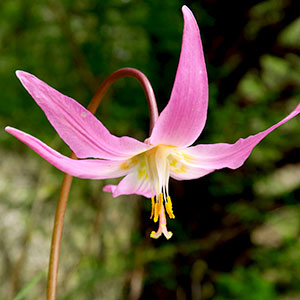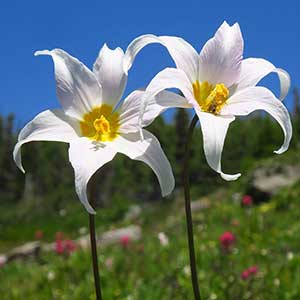Erythronium revolutum
Erythronium montanum
coast fawn lily, mahogany fawn lily, pink fawn-lily
avalanche-lily, white avalanche-lily, white glacier lily
narrowly ovoid, 35–50 mm, sometimes producing sessile offsets.
narrowly ovoid, 25–60 mm.
10–25 mm;
blade distinctly mottled with irregular streaks of brown or white, broadly lanceolate to ovate, margins entire to ± wavy.
10–20 cm;
blade green, ovate to broadly lanceolate, base ± abruptly narrowed to petiole, margins wavy.
15–40 cm.
12–35 cm.
1–3-flowered.
1–3-flowered.
tepals uniformly clear violet-pink at anthesis, with yellow banding at base, lanceolate to narrowly elliptic, 25–40 mm, inner with small auricles at base;
stamens ± appressed to style, 12–22 mm;
filaments white to pink (darkening with age), flattened, ± lanceolate, 2–3 mm wide;
anthers bright yellow;
style white to pink, 12–18 mm;
stigma with slender recurved lobes 4–6 mm.
tepals white to creamy white with bright yellow zone at base, broadly ovate to broadly lanceolate, 25–45 mm, inner wider than outer, auriculate at base, length less than 4 times width;
stamens 12–24 mm;
filaments white, linear, slender, less than 0.8 mm wide;
anthers bright yellow;
style white, 13–25 mm;
stigma with slender, usually recurved lobes 1–5 mm.
oblong to obovoid, 3–6 cm.
oblong, 3–6 cm.
= 24.
Erythronium revolutum
Erythronium montanum
This species occurs in the Coast Ranges of southern British Columbia, and disjunctly to southern Vancouver Island, the Olympic Peninsula, and Cascade Mountains from Mount Rainier National Park in Washington to central Oregon.
(Discussion copyrighted by Flora of North America; reprinted with permission.)
- Local floras:
BC,
CA,
OR,
WA
- Local Web sites:
CalFlora,
CalPhotos,
Flora NW,
PNW Herbaria,
Turner Photog.
WildflowerSearch
iNaturalist (observations)
USDA Plants Database
- LBJ Wildflower Center
- SEINet
- Plants of the World Online
- Encyclopedia of Life
- Wikipedia
- Google Image Search



